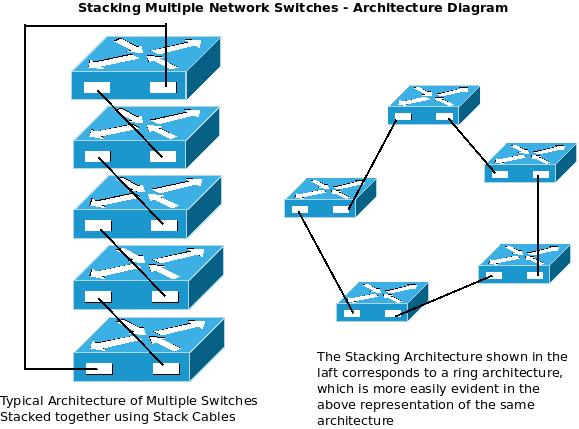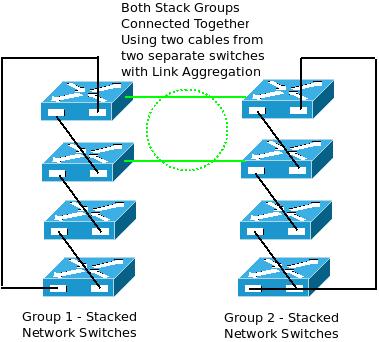How Stacking Multiple Network Switches helps to build a more resilient LAN
 Summary:
Summary:
There are number of ways to connect various network switches in a LAN. Stacking a group of network switches to form a single stack unit that can be managed with an individual IP address for all the switches in the stack group would not only make managing a lot of switches easier, it would also introduce switch level and link level redundancy. In this article, we analyze a few salient points about stacking multiple switches together and how various vendors have implemented it, in order to get a better idea about stacking multiple network switches and its advantages.
Salient Points you need to know about Stacking Switches:
- There is a single IP address for all the switches managed by the stack. This reduces the total number of IP addresses required in the network. Any configuration changes can be done once (usually in the master switch) and those configuration changes are applied to all the other switches, automatically. With many vendors – routing, multi-casting, spanning tree, QoS, Link Aggregation, etc can be applied globally to the entire stack. With some vendors, the stack group can be managed from their own utilities as well as any SNMP based management utilities.
- Usually, there is a master switch (which is either nominated by the user (or) selected automatically by the stack) which controls the operation of the entire stack. All configuration is generally done in the master switch, and are automatically propagated to other switches. If the master switch fails, another switch member in the stack group usually takes over as the master.
- One of the main advantages of stacking multiple switches together is to achieve switch level and link level redundancy. In the above diagram, a stacking (ring based) architecture is shown. Suppose a cable in that stack configuration goes down, the switch where the cable is connected can always be reached with the other cable connected to it. Even if a switch goes down, all the other switches are accessible to each other.
- Based on the vendor, there is generally a limitation to the maximum number of switches that can be stacked together. This maximum number can be 6,8,12,16, etc. Also, there are no standards for stacking. Hence multiple switches from different vendors (and) even multiple switches from different switch family of the same vendor (sometimes) cannot be stacked together. But some vendors offer stacking capabilities across their own family of switches.
- Generally, there are separate stacking ports and separate stacking cables. Most of these ports/ cables are proprietary and have more throughput than the maximum throughput supported by standard Ethernet ports (For example, 1 GE) it carries. The maximum distance supported by these cables is limited (for example, 3 meters). Some vendors offer stacking in the normal standards based Ethernet ports (1 GE/ 10 GE), and the usual Cat x cables which can extend the stacking up to 100 meters, sometimes even through other network switches. This technique is also referred to as clustering.
 With some vendors, its possible to connect two separate stack groups (of switches) using two or more links with link aggregation enabled between them so that even if one link fails, the other link(s) keep operating and all the links operate with the combined throughput of the individual links (If each link supports 1 GE, then the link operates at n x 1GE where n is the number of Link Aggregated links). With some vendors, these links can be from different switches in each stack group in order to provide link level as well as switch level redundancy for interconnection of multiple stack groups.
With some vendors, its possible to connect two separate stack groups (of switches) using two or more links with link aggregation enabled between them so that even if one link fails, the other link(s) keep operating and all the links operate with the combined throughput of the individual links (If each link supports 1 GE, then the link operates at n x 1GE where n is the number of Link Aggregated links). With some vendors, these links can be from different switches in each stack group in order to provide link level as well as switch level redundancy for interconnection of multiple stack groups.- Its possible (with some vendors) to apply certain functionalities, to any port of any switch in the stack group as if all the ports belong to one big switch. For example, port mirroring can be applied to the traffic passing through multiple switch ports in various switches of the stack group, and still the traffic from all these ports can be observed from one port – in the master switch (for example).
- The switches that form the stack group are flexible – its possible to operate them as a part of a stack group today, and operate them as individual switches tomorrow.
- Stacking switches might be more cost effective to deploy, especially in case of deploying low/medium end switches & in case of small deployments which gradually grow to become bigger over a period of time. This is in comparison to chassis based higher end switches.
- With some vendors its possible to remove and replace entire switches from a stack group without affecting the working of other switches in the stack. When new switches are introduced in the stack, it quickly takes the configuration from the other switches and becomes a member of the stack without much user intervention.
- When a link in a stack group fails, the fail-over time taken for the stack to reconfigure and send traffic through other links is very minimum (usually within a second). This is much better when compared to other similar processes like STP/VRRP, etc.
excITingIP.com
You could stay up to date on the various computer networking technologies by subscribing to this blog with your email address in the sidebar box that says ‘Get email updates when new articles are published’
the first two switches of both groups are interconnected using link aggregation. what will happen if you remove switch2 of group1 from the stack membership? what would be the outcome of the link aggregation and the stp topology?
Yeah Lad
your second diagram (on the right) of the switches arranged in a circle (for effect) seems to be a bit askew. the wire on the right side is going from port 2 to port 2 of the switch below it, and the one on the left side of the same diagram, it is going from port 1 of one switch to port 1 of the one below it. from my knowledge of stacking, the wire should ALWAYS go from port 1 to port 2, as it does in the diagram on the left. just saying, it might be a bit confusing for the uninitiated…